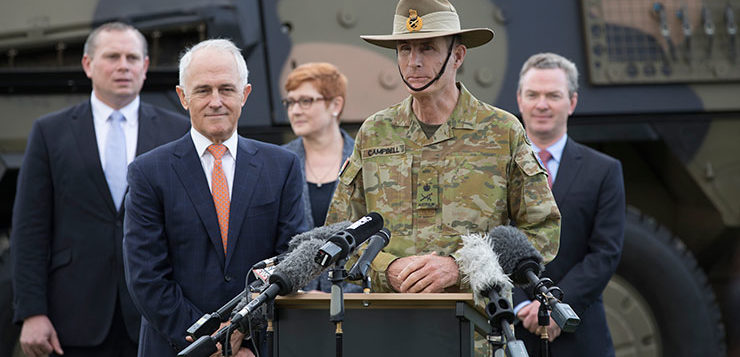Without national discussion or debate – and no hard questions from media – Australia is pitching to become a major arms exporter. Dr Lissa Johnson weighs in.
On Wednesday morning I watched a live broadcast of Prime Minister Malcolm Turnbull announcing the Australian Government’s deal to procure $5.2bn worth of tanks (combat reconnaissance vehicles) from German arms manufacturer Rheinmetall. It has been hailed as the largest defence contract in Australia’s history.
In front of a brand spanking new tank stood Turnbull, a Rheinmetall executive, Defence Minister Marise Payne and Defence Industry Minister Christopher Pyne. Together they sang the praises of their historic ‘procurement project’ and Rheinmetall’s state of the art combat vehicle.
Turnbull waxed lyrical about a “robust, resilient and internationally competitive defence industry”, “exciting opportunities” and “leading edge capability.” The arms executive talked about a “world class Military Vehicle Centre of Excellence” in Queensland. Turnbull described his ambition for Australia to become one of the top 10 defence exporters in the world.
The whole performance looked like a marketing event at a boat show, except the boat was a tank.
Turnbull proudly described the deal in the context of Australia’s plan to spend $200bn on new military equipment over the next decade. He said that the arms deal was good news for Australian steel, good news for jobs, good news for Queensland and good news for Australia (Victoria, which bid to host the contract, missed out).
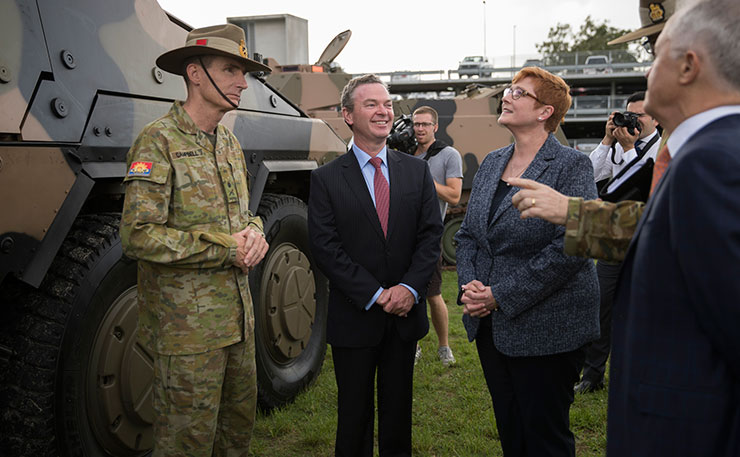
Turnbull and Pyne cited the Rheinmetall tank’s superior “lethality” as a key selling point. The arms manufacturer likened it to a Swiss army knife.
As I watched the broadcast my stomach churned, making it difficult to digest my breakfast. I had a few thoughts. One was that even if this deal is “good news for Queenslanders” as hyped, the whole $200bn arms ramp-up is bad news for some. Bad news, for instance, for anyone living in Yemen.
In Yemen, 8.4 million people are on the brink of famine and 11 million children require humanitarian assistance, in a population of 29 million. Those children are not receiving the assistance they need because of a Saudi-led, US, UK and Australia-backed, military blockade, using hunger and disease as a weapon of war, which is a war crime.
While they starve, Yemenis are being bombed from the air, and attacked on the ground in collaboration with Al-Qaeda and Al Qaeda-linked militants. Half of the country’s medical facilities have been destroyed, as a Cholera epidemic sweeps the nation. All this is being perpetrated using US, British and Australian weapons.
Why? Because it’s what Saudi Arabia, keeper of the petro-dollar, wants.
Although the UN’s Humanitarian Chief said on January 6th that the situation in Yemen “looks like apocalypse”, on January 16th, the US Army boasted on its Twitter feed that it would continue to boost the Saudi Military’s “powerful capability”.
“Capability” was a buzzword surrounding Australia’s new fleet of tanks on Wednesday as well. Capability for what? Inflicting apocalypse? Capability to starve and bomb millions of impoverished Yemeni people to death?
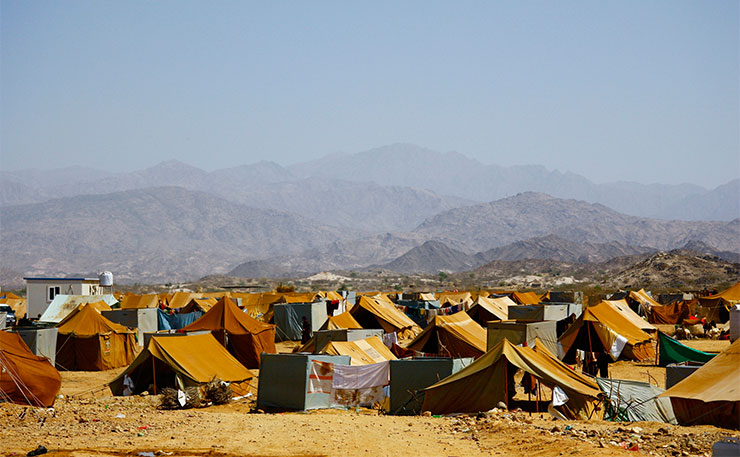
In a series of articles on Yemen for New Matilda last year, Michael Brull detailed the Australian Government’s complicity in the catastrophe unfolding in Yemen. He explained that Australia had approved nine military export permits to Saudi Arabia as of November 2017, provided diplomatic support for the war, and that Australian mercenaries were “serving in senior roles in the invading coalition”.
He subsequently exposed Australia’s cover-up of its arms sales to Saudi Arabia in the context of the war on Yemen, documenting the Australian Government’s refusal to disclose any information regarding its weapons sales to Saudi Arabia. He explained that Defence Minister Marise Payne had cited Australian arms dealers’ rights to “market opportunity”, “buyers’ confidence” and “commercial confidentiality” as her Government’s overriding concerns regarding arms sales to the Saudis.
It makes perfect sense, then, that Minister Payne would now be trading gratitudes and platitudes with an arms manufacturer in front of an expensive tank, given her stated commitment to arms dealers’ market opportunities.
Turnbull lauded market opportunities too. He spoke of linking Australia’s “economic security” with its “national security”. Which is neoliberalese for “profiting off of death”.
Linking economic security with national security is also known as military Keynesianism. Which is another way of saying ‘propping up economies using war’.
It was implemented in America following World War II, and appears to be America and Australia’s chosen strategy for propping up their economies now, with both countries ramping up military spending.
Why Australia needs $200bn for ‘national security’ is the $200bn question. If we were Iraq it might make sense. Iraq is at war. But Australia?
There are some countries one would expect to have large military budgets. Saudi Arabia and Israel, for instance, being regional powers surrounded by wars, are two examples. Germany, with its central role in NATO. Iraq, at war. South Korea, next door to North Korea. Ukraine, also at war.
But Australia?
Just out of curiosity, I wonder where Australia would sit in a list of buyers of US weapons. Given the 6 countries I mentioned above, perhaps 7th?
According to a 2016 list, Australia is practically equal second with Iraq, lagging behind only Saudi Arabia. Israel and South Korea are several places down the list. The other countries don’t even make the top 13.
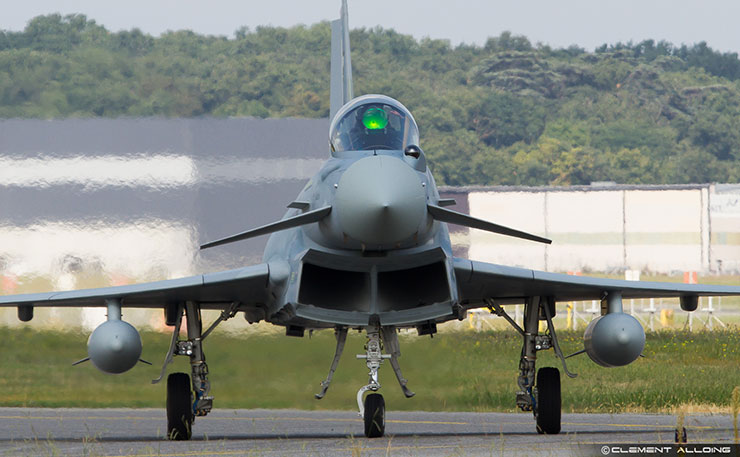
But do we really need almost as many weapons as Iraq?
Although there was Question Time after Turnbull’s procurement announcement on Wednesday, none of the journalists present asked that question, to my knowledge. Which was a shame.
Perhaps America already issued Australia with a military spending ‘benchmark’, as it has recently done with NATO member countries. America is demanding that NATO countries spend at least two per cent of GDP on weapons. When Tony Abbott was Prime Minister he set exactly that military spending goal for Australia.
What a coincidence that different countries, in very different parts of the world, with entirely different national security needs would require exactly the same level of military spending. It’s almost as though military spending has nothing to do with national security.
Another thought that passed through my mind as I was watching the announcement on Wednesday was “what else could be done with that $200bn?”
Military spending is a popular topic on the Jimmy Dore show (If you are interested in US politics and you consider yourself to be on the left, I highly recommend it).
Jimmy Dore frequently notes that $30bn would end world hunger and $20bn would end homelessness in the United States. With a population roughly one thirteenth that of America’s, imagine what Turnbull’s $200bn could achieve here.
Earlier this year New Matilda ran an article by Matt Steyn who looked at some of the things that could be done with a paltry $122m in Australia. That amount alone would fund our national mental health budget for a year.
Dore frequently points out that in the US, while free college tuition is forever out of reach, the US defence budget can readily stretch to an annual $80bn increase, over and above the existing $606bn, for weapons. No debate, no questions asked. This increase alone, he says, would fund free college tuition and wipe out student debt within 10 years.
Similarly, in Australia we are cutting funds to higher education, yet we can spare $200bn for arms. Why is that? To my knowledge no journalists covering Turnbull’s announcement asked that question either.
Jimmy Dore is one of the few in the US “lefty media”, as he calls it, to genuinely and consistently criticise the Military Industrial Complex and endless war. Perhaps that is why some of the most explosively viral articles on New Matilda have addressed that very theme, filling a media void worldwide.
In 2014, for example, after the Paris Attacks, Chris Graham wrote, ‘Paris Attacks Highlight Western Vulnerability, And Our Selective Grief And Outrage.’ The article received 457 thousand Facebook shares. I don’t know how many millions of reads that is, but it’s a lot.
Which brings me to another thought I had as I was watched Turnbull trading self-congratulations with a weapons manufacturer, while gushing about gobs of money, in front of a great big tank. Thank goodness for New Matilda.
New Matilda regularly publishes articles critiquing war and the global military machine. You can find them here.
In our corporate-government media, however, the uses to which we and our allies put our military hardware is rarely questioned. Western governments’ complicity in arming the horrific systematic murder of the people of Yemen, where one third of air raids have targeted non-military sites, is a current example.
Yemen provides the human face of Turnbull’s “exciting” Military Keynesianism. Our mainstream media refuses to look that face in the eye.

Another studiously ignored subject is the reality of the other current US-Saudi military campaign, the dirty war in Syria, which has been whitewashed with millions of dollars of Western government and NATO money, poured into propaganda campaigns, comprehensively detailed by Professor Tim Anderson of Sydney University here.
For my money, however, there is one story about the Military Industrial Complex that stands out as perhaps the most critically under-reported in recent years. It concerns this report by Professor Peter Phillips and colleagues at Sonoma State University.
Phillips is a Professor of Political Sociology and the Sociology of Media. He and his colleagues have compiled a report on the machinations of contemporary corporate media, and its relationship to the military.
Contrary to old-fashioned conceptions of news and current affairs, the authors describe a media apparatus in which the majority of corporate media ‘news’ does not entail what most of us consider to be journalism. Most contemporary news, the report claims, upwards of 80 per cent, is fed to news organisations by public relations and propaganda (PRP) firms.
Phillips and colleagues write, “the media is increasingly dependent upon various governmental and PRP sources to generate news. Maintenance of a continuous news cycle requires a constant feed and an ever-entertaining supply of stimulating events and breaking news clips and sound bites. The twenty-four-hour news shows on MSNBC, Fox, and CNN maintain constant contact with the White House, Pentagon, and PRP companies representing both government and private corporations.”
Phillips notes that in 1999 the editor of the Washington Post told him that approximately two thirds of Washington Post news stories came from PR sources at that time. Philips writes, “it was estimated 13 years ago that up to 80 per cent of all news stories in corporate media were sourced from or directly influenced by PRP firms. PRP penetration into corporate media has only increased to the present day.”
Now, he says, “Journalists are taking an increasingly dependent secondary position to PRP firms and government press releases in corporate news media.”
In their report, the authors detail the main PRP firms and their clients, explain their methods and provide examples. The PRP firms they cite work for corporations, Governments, the Pentagon, NATO, and various militaries, including the Australian Defence Force, which is listed as using the conglomerate WPP, a firm with an annual revenue of $12.2bn in 2015.
The influence of military PRP on ‘news’ is such that the authors coined the term ‘military-industrial-media complex.’ “The world today”, they say, “faces a PRP-military-industrial-media empire so powerful and complex that, in the majority of news venues, basic truths about world events are concealed, skewed, or simply not reported at all.”
PR firm The Rendon Group, for instance, helped to create public support for both the first Gulf War and the permanent war on terror. Among other things, it provided images and fabricated stories. “Pentagon documents show 35 contracts with the Rendon Group between 2000 and 2004 worth a total of fifty to one hundred million dollars.”
WPP’s Burson-Marsteller “created the front group Global Climate Coalition (GCC), which operated from 1989 to 2001… to help the oil and auto industries downplay the dangers of global warming”.
And WPP’s Hill & Knowlton were behind the incubator babies stunt that paved the psychological way for the first Gulf war.
Globally the three largest PRP conglomerates generate an annual $35bn in revenue.
The Washington Times writes, “The [US] government has spent more than $16 billion over the last decade on outside advertising, marketing and public relations contractors” who “help federal agencies burnish their images and tailor their messages”.
While the article lists various innocuous public relations contracts, it notes that the Pentagon was one of the largest PR spenders.
However, “Not all of the contractors can be publicly tracked. The government – especially the Defense and State Departments – hires many foreign firms for advertising, marketing or communications work, and refuses to disclose their names. About $161 million over the last decade was awarded to ‘miscellaneous foreign contractors’”.
Many people have by now woken up to the fact that corporate and government media serve their corporate and political masters, therefore avoiding stories and angles that might bite the hand that feeds them.
But the Sonoma University report paints a starker picture than that. The authors argue that “the expansion of PRP firms inside news corporations” has produced “a far more deliberate form of news management”. The net result, they say, is the ability to co-ordinate messages which are issued “repeatedly to the American people and the world, until those messages become self-evident truths and conventional wisdom”.
Such as ‘arms deals good’.
Christopher Pyne seemed to have received his PRP briefing on Wednesday when he said, “We’re providing the capability [capability – there’s that word again]the Defence Force needs to be a modern army”. ‘Modernisation’ writes Adam Johnson of Fairness and Accuracy in Reporting, is the media’s favourite euphemism for military build-up.
Rheinmetall executive Ben Hudson obviously got the memo too. He talked of “enduring partnership with government to… modernise this world-leading capability”.
Day-to-day, in addition to reliance on PRP firms for ‘news’, PRP takes the form of uncritically repeating government press releases and talking points (such as ‘modernisation’), failing to ask the hard questions, cut-and-paste journalism, the demise of investigative reporting and reliance on “think-tanks”, many of whom are funded by not only corporations but the military and/or the Gulf states (for a critique of Australian think tanks, Antony Loewenstein has done some excellent work).
Or, alternatively, PRP simply takes the form of blatant advertising. Such as this news.com ‘report’ on the Rheinmetall weapons deal, with a promo clip showing the tank gliding sleekly through pristine snow, to reassuring music, while words such as “agile” float weightlessly across the screen. Not a bloodstain in sight. Repeat after me: it’s just a pleasure cruiser, it’s just a pleasure cruiser, it’s just a pleasure cruiser.
The PRP approach to ‘news’ also involves an absence of critique. The only controversy the dominant Australian media seems willing to entertain regarding the new procurement contract, for instance, is whether the state of Queensland or Victoria won the deal.
Critique of military Keynesianism is absent. Whether Australians would prefer to stimulate our economy via spending on education rather than the military, for instance, goes undiscussed.
The tactic of focussing myopically on Victoria and Queensland’s row over the deal, moreover, places the deal’s value beyond dispute. Even worse, Victoria is cast as the only victim in the equation. Not a Yemeni in sight.
Absent from the discussion also are questions around whether we should consider stimulating our economy with green jobs rather than tanks (that would be real journalism). It wouldn’t be difficult to ask one of our politicians why we don’t fund a renewable energy program that creates jobs by protecting lives, rather than taking lives away.
Another question worth asking is, does this deal really stack up in terms of jobs? The new $5.2bn arms deal is expected to produce 1,450 jobs over 30 years. That’s approximately 48 jobs a year. I don’t mean to disparage the significance of 48 jobs a year, but for $5.2bn it doesn’t seem like a lot. In fact, if my calculations are correct, that’s over $3.5 million per job.
There must be better ways to create jobs.
China, for example, is spending $493bn on renewable power generation by 2020, which is expected to create 13 million jobs. That’s approximately $38,000 per job.
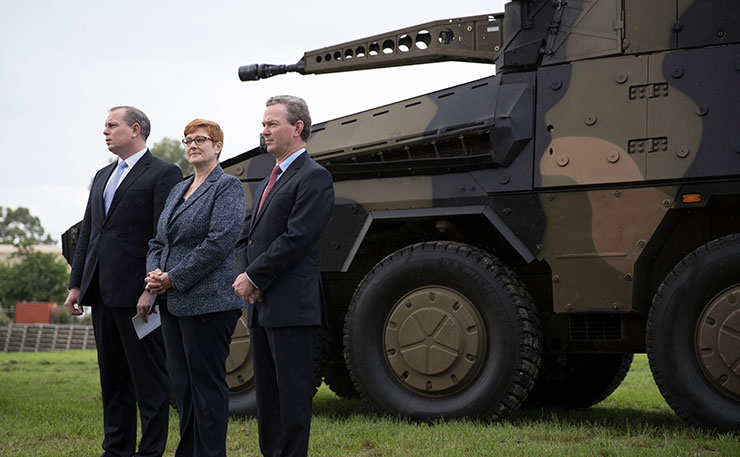
Mr Ben Hudson, Global Head Vehicle Systems Division, Rheinmetall Defence, Minister for Defence Senator the Hon Marise Payne and Minister for Defence Industry The Hon Christopher Pyne MP at the announcement of Project LAND 400 Phase 2 where Defence will acquire 225 Rheinmetall Boxer Combat Reconnaissance Vehicles (CRV) to replace the Australian Light Armoured Vehicle (ASLAV). (IMAGE: Jay Cronin, Dept of Defence)
I know wages and conditions are different in the two countries so they can’t be directly compared. I would use a green example from the US or Australia, but we don’t have comparable green energy programs. We’re spending our money on weapons and tanks.
Wouldn’t it be wonderful if we had some journalists covering this, though, who asked why we’re spending $3.5m per job? Someone who would ask where the rest of that money goes?
How much is profits for the arms dealers, for example? Have any political donations been made? At arm’s length perhaps? Just asking.
Perhaps not, but such questions might arouse public interest, if not media interest, in Rheinmetall’s history of corruption scandals, bribery scandals and blacklisting. As recently as a couple of weeks ago the German company was described by a German MP as “tainted”.
I have found no mention of that in the Australian reports of our new deal with Rheinmetall.
It looks increasingly as though media coverage of the Rheinmetall procurement contract would make an excellent case study in PRP as described by Phillips. It illustrates the following principle particularly well: “The result is news managed by government and PRP firms – often interlocked – including the release of specific stories intended to build public support as well as the deliberate non-coverage of news stories that may undermine” the message.
In other words, it’s not bad journalism. It’s just not journalism. It’s PR.
Absent also from coverage of the announcement yesterday is the fact that the military is the “single greatest institutional contributor to climate change”. Raising this impertinent fact would in turn beg questions over the wisdom of propping up the military while the biosphere collapses.
Finally, although Turnbull linked the Rheinmetall deal to Australia’s military export ambitions, media reports seem to have ignored that context.
At the time of writing, no reports that I can find have referred back to Australia’s current “push to sell military hardware in the Asia-Pacific region and the Middle East, including in Saudi Arabia”. Nor have they mentioned Christopher Pyne’s recent visits to Saudi Arabia “in a bid to increase Australia’s arms exports to the Middle East regime, which is one of the world’s biggest arms buyers”.
Perhaps the PRP teams preferred to steer clear of that backdrop, in case anyone remembered that Saudi Arabia is a world leader in theocracy, gender apartheid, religious persecution, enslavement, beheadings and the exporting of terrorism.
In short, no hard questions are being seriously asked about this weapons deal in the Australian mainstream media. Not one out of a gamut of possibilities.
In America, the military’s capture of the media is increasingly blatant. Jeff Bezos, founder of Amazon, owns the Washington Post and has a $600m contract with the CIA. He also sits on a Pentagon Board.
Cable news channels are openly populated with CIA officials and generals. Former CIA Director John Brennan, for example, was recently appointed as senior national security intelligence analyst for NBC News and MSNBC. Generals paid by military contractors routinely offer commentary and analysis, of the pro-war variety, while their financial conflicts of interest remain undisclosed to viewers.
In Australia, although the generals and intelligence officials aren’t as front and centre as in the United States, our defence forces draw on the same pool of PRP firms. And much of our foreign affairs news comes from the American PRP machine.
Which brings me back to an earlier point. Thank goodness for independent media. Reader-funded media is not only free from the corrupting force of advertising, it is a last bastion of genuine journalism. Of the kind of journalism that offers critique and asks difficult questions.
Which is a not-so-subtle way to urge you to subscribe to New Matilda. Because the media landscape needs independent, reader-funded media now more than ever.
The PRP news model is not the only reason, as if that weren’t enough. In the United States, many of the best independent media outlets are currently being targeted for suppression.
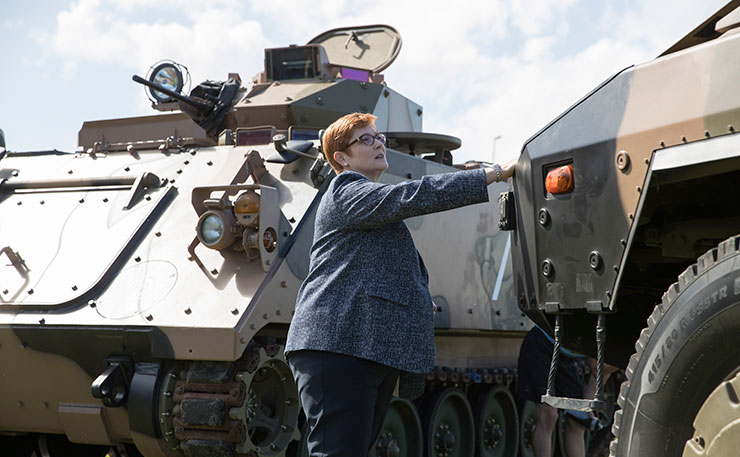
Minister for Defence Senator the Hon Marise Payne talk to Australian Army soldiers at the announcement of Project LAND 400 Phase 2 where Defence will acquire 225 Rheinmetall Boxer Combat Reconnaissance Vehicles (CRV) to replace the Australian Light Armoured Vehicle (ASLAV). (IMAGE: Jay Cronin, Dept of Defence)
Google has been de-prioritising rankings of websites such as Consortium News, Black Agenda Report, World Socialist Website, Counterpunch, Truthdig, Global Research and others, reducing their traffic by as much as 60 percent. YouTube has also been unsubscribing people from independent news shows, such as Jimmy Dore’s, and de-monetising videos, significantly reducing viewership.
The outlets being targeted all have one thing in common. And it’s not Russia. They critique corporatism, endless war and the Military Industrial Complex.
At a recent summit titled ‘Organising Resistance To Internet Censorship’ John Pilger said, “Something has changed. Although the media was always a loose extension of capital power, it is now almost fully integrated. Dissent once tolerated in the mainstream has regressed to a metaphoric underground as liberal capitalism moves toward a form of corporate dictatorship. This is an historic shift, with journalists policing the perimeters of the new order.”
While our media in Australia may not yet be owned by a man with a $600mn CIA contract, Jeff Bezos is coming to a media outlet near you. In a New Matilda article on Australian media reform last year, Ben Eltham argued that unless we’re careful, our media could end up “monopolised by a single firm and owned by a single billionaire”.
Reading independent media for free helps the Bezos’s of the world, by ensuring that reader-funded media is unlikely to survive. Unselfishly, I urge you to subscribe to New Matilda to keep the independent media landscape in Australia alive.
Selfishly, I urge you to subscribe to New Matilda. So that I, and all the other contributors here, can continue to write.
I’ve been quiet on New Matilda for a while due to family demands. But I’m now working on a series of articles tracing a psychological history of the relationship between North Korea and the United States. I hope to have the series finished in time for the summit between Donald Trump and Kim Jong-un in May.
It’s hard to know how that summit will play out. But I am confident of one thing. Whatever Australia’s stance on North Korea at that time, our corporate media will fail to seriously examine the role of our military export ambitions in the region.
That would be too much like journalism.
Donate To New Matilda
New Matilda is a small, independent media outlet. We survive through reader contributions, and never losing a lawsuit. If you got something from this article, giving something back helps us to continue speaking truth to power. Every little bit counts.

